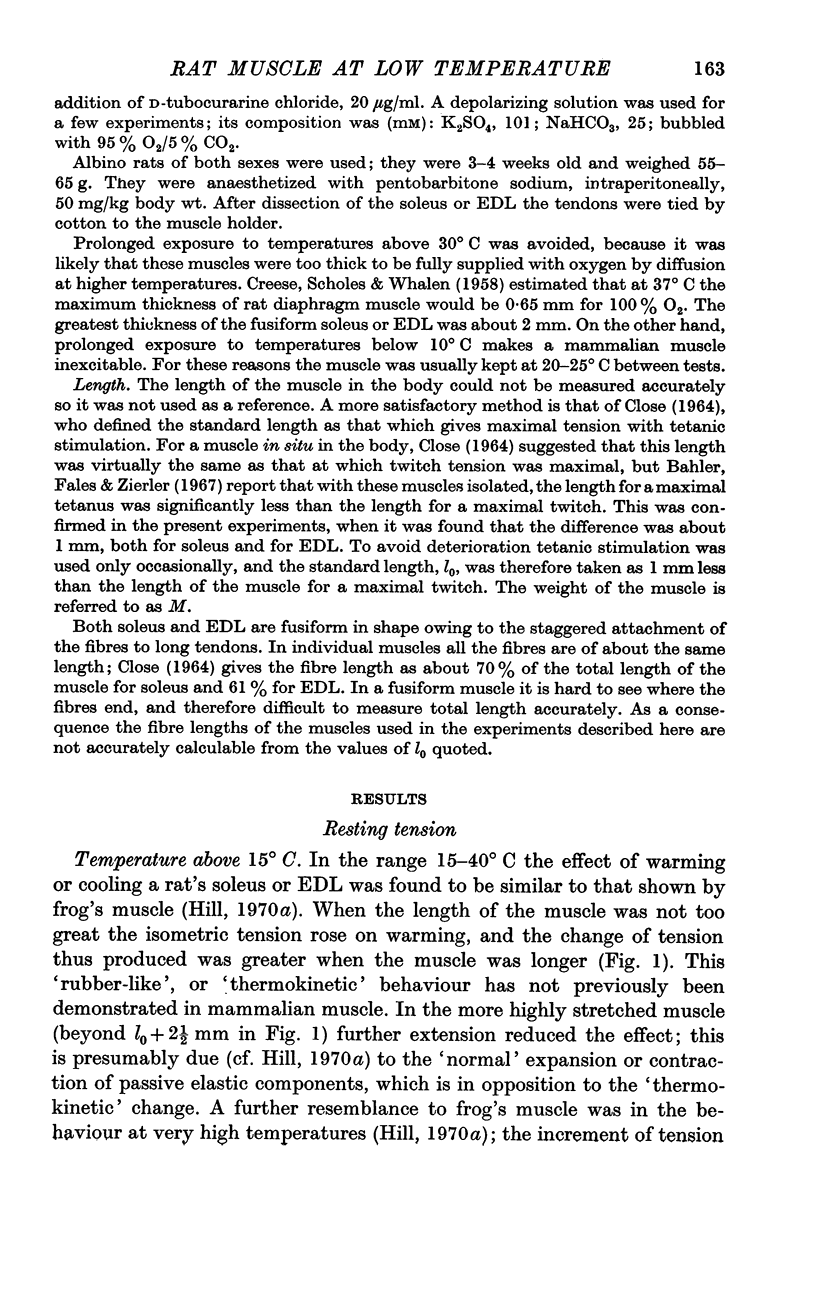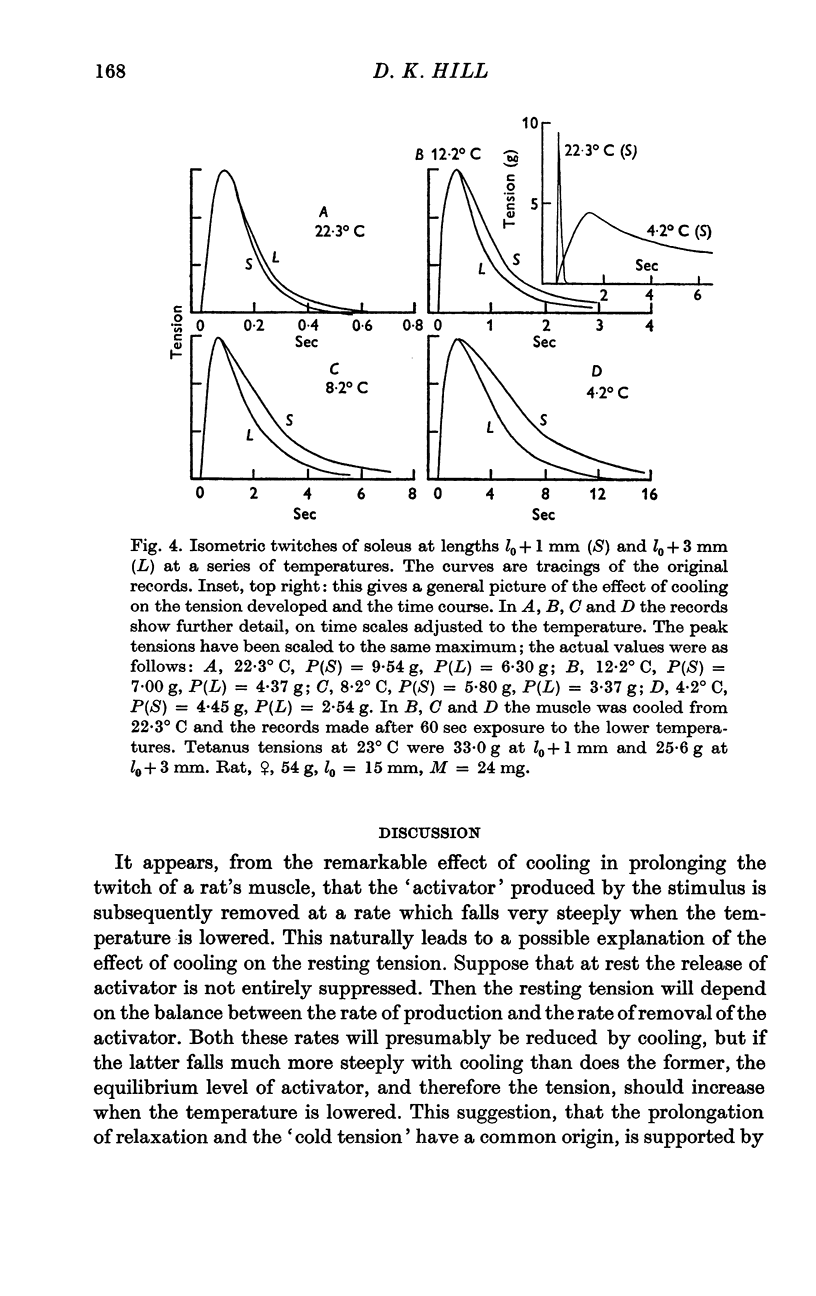Abstract
1. A study has been made of the effect of temperature on the resting tension and on the form of the isometric twitch of isolated rat skeletal muscle. The soleus and the extensor digitorum longus (EDL) were used as representatives of slow and fast types of muscle. The main interest is in the behaviour at low temperature, when rat muscle shows characteristics which are not found with frog muscle.
2. At higher temperatures both soleus and EDL of the rat resemble frog muscle in showing a `rubber-like' form of resting tension, i.e. the tension increases with warming: this has not previously been demonstrated in mammalian muscle. But at low temperatures (below 15° C) the converse is observed; tension then increases as temperature falls. This `cold tension' is much larger with soleus than with EDL. The `cold tension' is the converse of the `rubber-like' tension also in its dependence on length; it becomes smaller when the muscle is stretched.
3. These muscles remain excitable and give consistent twitches with transverse stimulation at temperatures down to about 3° C provided the exposure to cold is not prolonged beyond a few minutes. The amplitude of the twitch is reduced by cooling, e.g. at 3° C it is about 30-50% of that at 25° C.
4. The twitch becomes very prolonged at low temperatures. With a soleus at 3-4° C it may last 40 sec. The temperature coefficient of the rate constant of the relaxation phase is very high compared with that of frog's muscle.
5. The rate constant of relaxation in a twitch at low temperature increases when the muscle is stretched. This is the reverse of what happens at higher temperature.
6. The extreme prolongation of the twitch with cooling indicates a very large decrease in the rate of decay of the active state, and it is suggested that the increase of resting tension at low temperature is due to an accumulation of `activator'.
Full text
PDF










Selected References
These references are in PubMed. This may not be the complete list of references from this article.
- Bahler A. S., Fales J. T., Zierler K. L. The active state of mammalian skeletal muscle. J Gen Physiol. 1967 Oct;50(9):2239–2253. doi: 10.1085/jgp.50.9.2239. [DOI] [PMC free article] [PubMed] [Google Scholar]
- CLOSE R. DYNAMIC PROPERTIES OF FAST AND SLOW SKELETAL MUSCLES OF THE RAT DURING DEVELOPMENT. J Physiol. 1964 Sep;173:74–95. doi: 10.1113/jphysiol.1964.sp007444. [DOI] [PMC free article] [PubMed] [Google Scholar]
- CREESE R., NORTHOVER J. Maintenance of isolated diaphragm with normal sodium content. J Physiol. 1961 Feb;155:343–357. doi: 10.1113/jphysiol.1961.sp006632. [DOI] [PMC free article] [PubMed] [Google Scholar]
- CREESE R., SCHOLES N. W., TAYLOR D. B. Temperature and resting potential of diaphragm muscle in a CO2-bicarbonate medium. J Pharmacol Exp Ther. 1958 Sep;124(1):47–52. [PubMed] [Google Scholar]
- CREESE R., SCHOLES N. W., WHALEN W. J. Resting potentials of diaphragm muscle after prolonged anoxia. J Physiol. 1958 Feb 17;140(2):301–317. doi: 10.1113/jphysiol.1958.sp005935. [DOI] [PMC free article] [PubMed] [Google Scholar]
- Close R., Hoh J. F. Influence of temperature on isometric contractions of rat skeletal muscles. Nature. 1968 Mar 23;217(5134):1179–1180. doi: 10.1038/2171179a0. [DOI] [PubMed] [Google Scholar]
- Close R., Hoh J. F. The after-effects of repetitive stimulation on the isometric twitch contraction of rat fast skeletal muscle. J Physiol. 1968 Jul;197(2):461–477. doi: 10.1113/jphysiol.1968.sp008570. [DOI] [PMC free article] [PubMed] [Google Scholar]
- Hartree W., Hill A. V. The nature of the isometric twitch. J Physiol. 1921 Nov 18;55(5-6):389–411. doi: 10.1113/jphysiol.1921.sp001984. [DOI] [PMC free article] [PubMed] [Google Scholar]
- Hill D. K. Tension due to interaction between the sliding filaments in resting striated muscle. The effect of stimulation. J Physiol. 1968 Dec;199(3):637–684. doi: 10.1113/jphysiol.1968.sp008672. [DOI] [PMC free article] [PubMed] [Google Scholar]
- Hill D. K. The effect of temperature in the range 0-35 degrees C on the resting tension of frog's muscle. J Physiol. 1970 Jul;208(3):725–739. doi: 10.1113/jphysiol.1970.sp009145. [DOI] [PMC free article] [PubMed] [Google Scholar]
- Hill D. K. The effect of temperature on the resting tension of frog's muscle in hypertonic solutions. J Physiol. 1970 Jul;208(3):741–756. doi: 10.1113/jphysiol.1970.sp009146. [DOI] [PMC free article] [PubMed] [Google Scholar]
- Isaacson A., Hinkes M. J., Taylor S. R. Contracture and twitch potentiation of fast and slow muscles of the rat at 20 and 37 C. Am J Physiol. 1970 Jan;218(1):33–41. doi: 10.1152/ajplegacy.1970.218.1.33. [DOI] [PubMed] [Google Scholar]
- JEWELL B. R., WILKIE D. R. The mechanical properties of relaxing muscle. J Physiol. 1960 Jun;152:30–47. doi: 10.1113/jphysiol.1960.sp006467. [DOI] [PMC free article] [PubMed] [Google Scholar]
- MARTONOSI A., FERETOS R. SARCOPLASMIC RETICULUM. I. THE UPTAKE OF CA++ BY SARCOPLASMIC RETICULUM FRAGMENTS. J Biol Chem. 1964 Feb;239:648–658. [PubMed] [Google Scholar]


